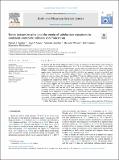Files in this item
Boron isotope insights into the origin of subduction signatures in continent-continent collision zone volcanism
Item metadata
| dc.contributor.author | Sugden, Patrick | |
| dc.contributor.author | Savov, Ivan | |
| dc.contributor.author | Agostini, Samuele | |
| dc.contributor.author | Wilson, Marjorie | |
| dc.contributor.author | Halama, Ralf | |
| dc.contributor.author | Meliksetian, Khachatur | |
| dc.date.accessioned | 2021-09-20T09:30:07Z | |
| dc.date.available | 2021-09-20T09:30:07Z | |
| dc.date.issued | 2020-05-15 | |
| dc.identifier | 275858209 | |
| dc.identifier | 234c5535-e45f-46db-9429-eb31ff48815f | |
| dc.identifier | 85081649990 | |
| dc.identifier.citation | Sugden , P , Savov , I , Agostini , S , Wilson , M , Halama , R & Meliksetian , K 2020 , ' Boron isotope insights into the origin of subduction signatures in continent-continent collision zone volcanism ' , Earth and Planetary Science Letters , vol. 538 , 116207 . https://doi.org/10.1016/j.epsl.2020.116207 | en |
| dc.identifier.issn | 0012-821X | |
| dc.identifier.uri | https://hdl.handle.net/10023/23989 | |
| dc.description | This work was supported as part of Patrick Sugden's PhD studentship funded through the Leeds-York SPHERES NERC doctoral training partnership (NE/L002754/1). Part of the fieldwork and research was funded by the University of Leeds, the Carnegie Institution of Washington, the ERASMUS exchange programme (for IS) and the Science Committee of the Armenian Ministry of Education and Science (project #18T-1E368). The majority of the B isotope analytical work was supported by IGG-CNR funds P1600514. | en |
| dc.description.abstract | We present the first boron abundance and δ11B data for young (1.5-0 Ma) volcanic rocks formed in an active continent-continent collision zone. The δ11B of post-collisional volcanic rocks (−5 to +2‰) from the Armenian sector of the Arabia-Eurasia collision zone are heavier than mid-ocean ridge basalts (MORB), confirming trace element and isotope evidence for their derivation from a subduction-modified mantle source. Based on the low B/Nb (0.03-0.25 vs 0.2-90 in arc magmas), as well as low Ba/Th and Pb/Ce, this source records a subduction signature which is presently fluid-mobile element depleted relative to most arc settings. The heavier than MORB δ11B of post-collision volcanic rocks argues against derivation of their subduction signature from a stalled slab, which would be expected to produce a component with a lighter than MORB B, due to previous fluid depletion. Instead, the similarity of δ11B in Plio-Pleistocene post-collision to 41 Ma alkaline igneous rocks also from Armenia (and also presented in this study), suggests that the subduction signature is inherited from Mesozoic-Paleogene subduction of Neotethys oceanic slabs. The slab component is then stored in the mantle lithosphere in amphibole, which is consistent with the low [B] in both Armenian volcanic rocks and metasomatic amphibole in mantle xenoliths. Based on trace element and radiogenic isotope systematics, this slab component is thought to be dominated by sediment melts (or supercritical fluids). Previously published δ11B of metasediments suggests a sediment-derived metasomatic agent could produce the B isotope composition observed in Armenian volcanic rocks. The lack of evidence for aqueous fluids preserved over the 40 Myr since initial collision supports observations that this latter component is transitory, while the lifetime of sediment melts/supercritical fluids can be extended to >40 Myr. | |
| dc.format.extent | 11 | |
| dc.format.extent | 1764442 | |
| dc.language.iso | eng | |
| dc.relation.ispartof | Earth and Planetary Science Letters | en |
| dc.subject | Post-collisional volcanism | en |
| dc.subject | Boron isotopes | en |
| dc.subject | Subduction signature | en |
| dc.subject | GE Environmental Sciences | en |
| dc.subject | NDAS | en |
| dc.subject.lcc | GE | en |
| dc.title | Boron isotope insights into the origin of subduction signatures in continent-continent collision zone volcanism | en |
| dc.type | Journal article | en |
| dc.contributor.institution | University of St Andrews. School of Earth & Environmental Sciences | en |
| dc.identifier.doi | https://doi.org/10.1016/j.epsl.2020.116207 | |
| dc.description.status | Peer reviewed | en |
| dc.identifier.url | https://www.sciencedirect.com/science/article/pii/S0012821X20301503?via%3Dihub#se0110 | en |
This item appears in the following Collection(s)
Items in the St Andrews Research Repository are protected by copyright, with all rights reserved, unless otherwise indicated.

